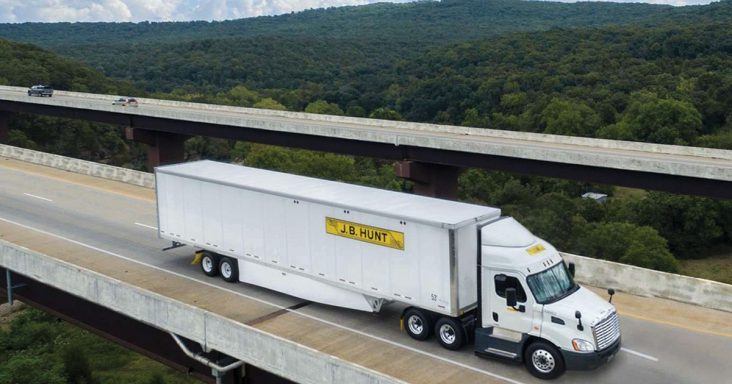J.B. Hunt to narrowly miss Wall Street 3Q projections, analysts say
by October 12, 2022 10:50 am 1,108 views

Lowell-based carrier J.B. Hunt Transport Services Inc. is expected to post double-digit gains in third-quarter earnings and revenue amid economic and freight market uncertainty.
After the markets close Tuesday (Oct. 18), the carrier is expected to report earnings per share of $2.45 in the third quarter, up from $1.88 in the same period last year, based on a consensus of 24 analysts. Revenue is projected to increase by 21.3% to $3.81 billion from $3.14 billion.
In an earnings preview, analysts Justin Long and Jack Atkins and associates Brady Lierz and Grant Smith, all of Little Rock-based Stephens Inc., expect J.B. Hunt’s third-quarter results to be “slightly below the Street, primarily from lower-than-expected intermodal volumes due to weak rail service and sequential pressure in the (brokerage) segment due to moderating margins.”
Still, the analysts said investor sentiment “is muted with low expectations” before the earnings report. The existing economic and freight market uncertainties are expected to be difficult to overcome, but the analysts were confident that J.B. Hunt will outperform next year. They see strong drivers for demand in the carrier’s intermodal and dedicated segments and noted the growth opportunity resulting from the expanded collaboration with BNSF.
The analysts expect J.B. Hunt to remain resilient “in a mild recession” with earnings either flat or up, “followed by years of significant growth.” They added that J.B. Hunt “offers the best risk/reward on our coverage list” and maintained an overweight (buy) rating for the stock. They lowered the 12-month target price by $15 to $200.
Shares of J.B. Hunt (NASDAQ: JBHT) were trading Wednesday morning at $167.90, up $4.25 or 2.6%. In the past 52 weeks, the stock has ranged between $153.92 and $218.18.
Following is a preview by segment:
INTERMODAL
The analysts expect rail service weakness to affect third-quarter intermodal volumes. Box turns are expected to be down in the quarter, from the second quarter. Intermodal volumes are projected to rise by 6% in the third quarter from last year’s period.
“We are cautiously optimistic this quarter will be the bottom in (J.B. Hunt’s) rail service due to a combination of a tentative labor agreement recently being reached with the rails/unions, planned increases to headcount for the rails and an enhanced collaboration with BNSF that should benefit fluidity in the year/s ahead. In addition, we expect (year-over-year) strength in intermodal yields to persist in the near term and are modeling (third-quarter) intermodal operating margins of 11.5% that are flat sequentially after adjusting for the irregular insurance expense in (the second quarter).”
In 2023, the analysts expect intermodal volumes to rise by 6.5%, from 2022, as a result of pent-up demand and growth resulting from the BNSF collaboration that’s partially offset by economic weakness. Intermodal pricing is projected to fall by about 3%. Intermodal operating income is expected to fall by about 3% in 2023, from 2022.
The analysts also noted that as of Jan. 1 Schneider will no longer transport its intermodal freight via BNSF, and this will be an opportunity for J.B. Hunt to fill this railroad capacity. They believe this should help J.B. Hunt outgrow the domestic intermodal market in 2023 and the future. They pointed to recent developments as evidence supporting this, including BNSF’s plans to add a $1.5 billion rail facility in Barstow, Calif., to help reduce port and freeway congestion around the ports of Los Angeles and Long Beach. Also, BNSF plans to open an intermodal facility in Tacoma, Wash., to meet increased demand in the Pacific Northwest.
“Bottom line, we are starting to see BNSF make meaningful investments that should help support future growth in intermodal with (J.B. Hunt) helping lead this charge,” the analysts said. The carrier recently announced expanding transload service in the Pacific Northwest and near the Mexico border.
DEDICATED
The analysts expect the carrier to report a stable growth pipeline despite the existing economic and freight market concerns as private fleets continue to look to outsource their transportation needs. Third-quarter truck sales are projected to exceed the carrier’s target of 1,000 to 1,200 units annually.
After this period, the analysts expect fleet additions of about 400 trucks per quarter, down from the previous 12-month average of about 550 trucks per quarter. Third-quarter operating margins are projected to be 10.5%, flat from the second quarter. Over the next 12 months, the analysts are confident that margins will improve as startup costs moderate.
“And even in a mild recession, we see a path for dedicated operating income to grow substantially in 2023,” the analysts said. “Our model assumes (a year-over-year increase of more than 20%).”
BROKERAGE
Volumes are projected to fall by 1% in the third quarter, from the same period last year, as a result of pressure in less-than-truckload volumes. Truckload volumes are expected to rise, outperforming the broader market. Freight market weakness is likely to affect the segment’s spot performance in the third quarter. In the second quarter, the spot market comprised 52% of the segment’s revenue. Third-quarter gross margins are projected to fall by 2 percentage points to 14.2% from the second quarter.
